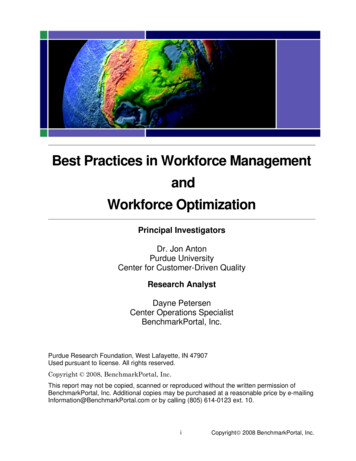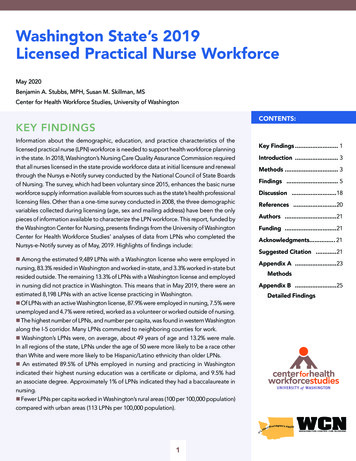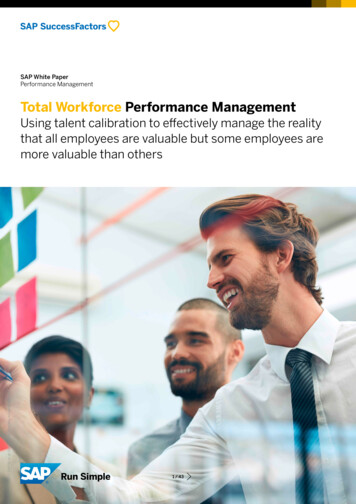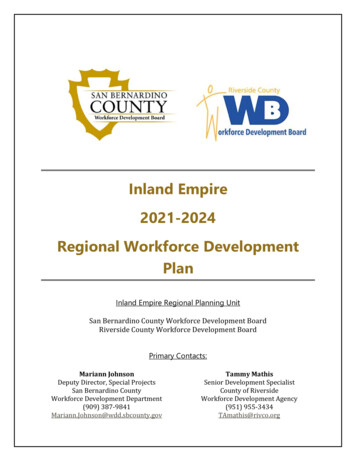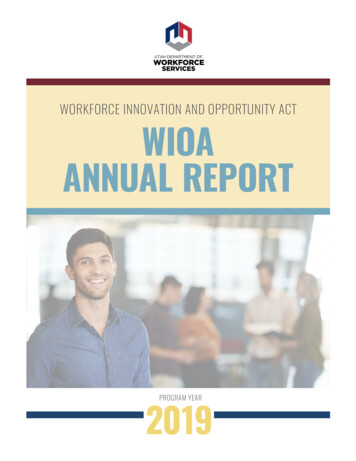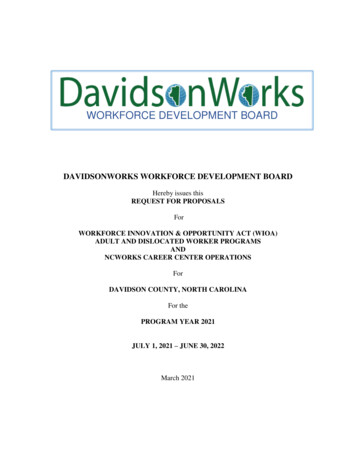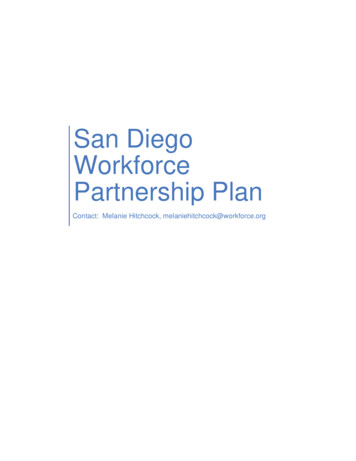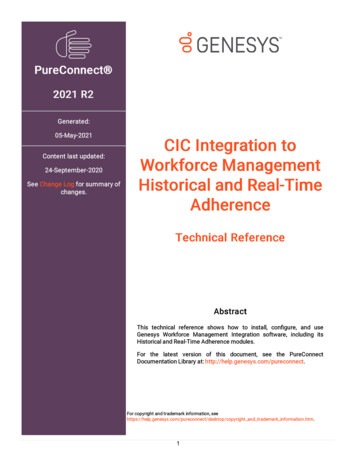
Transcription
Global Workforce ManagementBest Practice Approach to GlobalEmployment CompaniesFebruary 2018
ContentsExecutive Summary 01Global Employment Companies Overview 02Typical GEC locations 03Key issues to consider 04To GEC or not to GEC? 05Global Workforce Management Alternative deployment models 06GEC or REC vs. optimising the service delivery model 07Global Employment Companies Our approach 08Success factors 09Organisations with an existing GEC 10Potential benefits and challenges 11Team profiles 12
Global Workforce Management Best Practice Approach to Global Employment CompaniesExecutive SummaryGlobal organisations are increasingly asking questions aboutGlobal Employment Companies (GECs). These questions rangefrom those who are considering setting up a GEC and would like toknow how to do this, to those who are already operating a GEC andwould like to revisit their GEC structure, in light of the worldwideattention on corporate governance and responsible tax.GECs have come into and out of fashion over the years and itseems that they are now back in vogue, although for differentreasons. The key drivers for setting up GECs have changed andthe current focus is on global talent management, and facilitatingthe transparency of employee mobility as part of the corporateresponsibility debate.Our established approach to tackling the question‘to GEC or not to GEC?’ includes assessing the current state todetermine the best employment, deployment and/or servicedelivery model for each organisation based on their businessmodel and specific talent, mobility and reward requirements.This document provides various insights into the topic of GECsincluding the main considerations and key questions to ask todetermine whether a GEC is right for your organisation, alternativedeployment and service delivery optimisation models to considerif a GEC is not the best fit, and the support we can offer from theinitial thought process to the implementation of a new model,where this is required.Often the outcome of conversations with organisations who areconsidering implementing a GEC is very different to the originalintent. It is important to invest time to understand the challengesyour organisation is facing and the key drivers for change, toevaluate whether a GEC is in fact the right answer.www.deloitte.co.uk/gminsights@Deloitte #Globalmobility01
Global Workforce Management Best Practice Approach to Global Employment CompaniesGlobal Employment CompaniesOverviewSupporting business growth through talent alignment andmanagement of a borderless workforce is becoming key to operatingas one globally integrated organisation. Organising and managingemployees who are not aligned to a single country but are instead“global nomads” remains a significant and key strategic challenge. Itis important to differentiate between individuals or executives whotravel extensively on ad hoc, shorter term business trips, and globalnomads who undertake a series of longer term, planned internationalassignments with no plans to return to their “home” country or anyother specific country.An approach often considered to overcome this challenge is theestablishment of a global employment company (GEC), a separatesubsidiary that employs the business’ global nomads.A global employment company (GEC) is an incorporated entity whichforms part of an organisation’s group structure. Its purpose can includesimplifying or centralising operational processes and/or employinga distinct employee population to meet certain business and talentrequirements.Top GEC drivers in the market1. G lobal war for talent and globaltalent management2. Increased governance3. Global reward structureTimeline and evolvement of GEC business drivers1970s – 1980s1980s – 1990s2000s – TodayFocus on taking advantage of low taxand social security ratesFocus on managing risk of host countryattack on HQ profits via the creation ofa Permanent Establishmen erage may changedepending on the typeof deployment modeladopted. Pay levels are oftenestablished by roleand calculated takinginto account internalbusiness considerationsand competitive marketrates. The impact oftax and regulatoryenvironments in localgeographies is alsoconsidered in orderto come to a globallyharmonised model.www.deloitte.co.uk/gminsights GEC models can facilitatethe segmentationof groups of mobileemployees such asexecutives. The GECcan have separateprogrammes toincentivise certainbehaviours, reward andretention within thisgroup.@Deloitte #GlobalmobilityAddressing GlobalGovernance, Compliance& Risk Generally the greaterthe number ofhome-host countrycombinations, themore administrativelyburdensome themanagement ofcompliance such asimmigration, exchangecontrols, labour laws, taxand social security laws,anti-corruption laws andlaws addressing equitybased compensation. A GEC model mayreduce the number oflegislative combinationswhich need to beaddressed and thus limitgovernance costs andimprove compliancewhile minimising risk.Understanding GlobalCurrency Considerations A GEC can choose inwhich currency to deliverremuneration butconsideration should begiven to any host countryrequirements wherecompensation must bedelivered in the localcurrency. Most common currenciesused are the US dollar andthe Euro. Employees are usuallyresponsible for managingthe impact of exchangerate fluctuations betweenthe currency used by theGEC and their preferredcurrency.
Global Workforce Management Best Practice Approach to Global Employment CompaniesGlobal Employment CompaniesTo GEC or not to GEC?BeforeAfterHome based approachGEC deployment approachThere are many questions to consider in determining whether a GEC is the right approach:What type ofdeployments andbehaviours do we want tofacilitate/encourage?Will the creation of aGEC improve operationalefficiency?Do we understandthe tax and regulatoryimplications of how wemanage our talent?Can we capitalise on today’s twoway flow of talent by bringing peoplefrom developing markets into moresophisticated markets to providedevelopment opportunities, whiledeploying skilled employees to nurturetalent in the emerging markets?How do I define myglobal citizens?Can a GEC provide a more consistent,integrated view of how to evaluatepersonnel who are not aligned to aspecific geography or business unit butwill instead be in a globaltalent pool?Do we have a clear view of policiesand programmes that allow us todeploy our workforce in the bestinterests of both the organisationand the employees?How do our employees experiencethe company as a brand, organisationand place to work, and will a GEC helparticulate the value of being part of this?Will a GEC help provide a moreintegrated view of how we manageour financial resources, andunderstand the particular impacts ofentering emerging markets?www.deloitte.co.uk/gminsightsDepending onthe answersto thesequestions,some businesses find thata GEC is the best wayforward for them whereasothers conclude that adifferent type of globaltalent deployment model ismore suitable. Byaddressing issues relatedto management, rewardand risk, each companycan improve their ability tochoose the right approachfor them.@Deloitte #Globalmobility05
Global Workforce Management Best Practice Approach to Global Employment CompaniesGlobal Workforce ManagementAlternative deployment modelsA GEC may not necessarily be the right answer for your organisation. Consider the alternative deployment models outlined below.The organisations we work with vary in their approach to cross border mobility. There is no ‘one size fits all’ optimal deployment model.Understanding your key drivers for deploying global talent typically concludes that more than one type of model is required. From ourexperience most organisations utilise multiple models depending on the needs of their different globally mobile populations.1. Global Employment Company (GEC)*4. Home employment Sever or suspend home ties. Employment contractwith the GEC and assigned to the host country Encourages global mind set and career paths forglobal nomad population with no strong links to aparticular home or host country Commonly used to manage high volumes of verymobile employees with a number of home andhost country combinations Can generate potential tax and social securitysavings and minimise PE risk Remain employed by home country and assignedto host country Employees have ongoing link with home country Commonly used where employees are frequentlyin and out of the home country Home country compensation, benefits and payroll Central policy introduced and deploymentprocesses optimised Implementation of tracking and complianceprocesses required Low implementation cost and changemanagement required but may not address corebusiness requirements2. Regional Employment Company (REC)*5. Host employment Sever or suspend home ties. Employment contractwith the REC and assigned to the host country Encourages regional mind set and career paths forregional nomad population with no strong links toa particular home or host country Commonly used to manage high volumes of verymobile employees with a number of home and hostcountry combinations within a particular region Can generate potential tax and social securitysavings and minimise PE risk Sever or suspend home ties. Employmentcontract with the host country Host country compensation, benefits and payroll Central policy introduced and deploymentprocesses optimised Implementation of tracking and complianceprocesses required Low implementation cost and changemanagement required but may not address corebusiness requirements3. Regional Office Headquarters (ROH)6. ‘As is’ optimised Individuals are contracted into ROH andsubsequently assigned to the host country Back to back assignments as deemed necessary Requirement to comply with ROH legislation Creates physical ‘capability’ centre of expertise No creation of new entity Use existing group company structure to employindividuals Employment by entity dependent on costoptimisation Central policy introduced and deploymentprocesses optimised* Both the GEC and REC approaches can be implemented on a “Lite” basis where appropriate. This involves setting up the GEC or REC within an existing group company (instead ofcreating a separate legal entity).06www.deloitte.co.uk/gminsights@Deloitte #Globalmobility
Global Workforce Management Best Practice Approach to Global Employment CompaniesGlobal Workforce ManagementGEC or REC vs. optimising the service delivery modelSetting up a GEC or a REC potentially involves the cancellation of existing employment/secondment contracts and the implementationof new contracts with the new global or regional entity. Depending on your business drivers and desired outcomes, this may not berequired and an alternative solution for your business may be to optimise your global mobility service delivery model depending onyour business problem.Consider the following areas within your service delivery model. Are your challenges limited to any/all of these areas?Business/Functional SupportPolicy & Strategy HR support Policy, programme & service design HR programme/policy support Alignment of HR programmes with global function/business needs Assignee selection & planning Global HR strategy & design HR business planning at the function/business level Talent management Cost control & management reporting Exception management New country entryAdmin & CompliancePolicy &Strategy International mobilitycompensation, benefits,immigration, relocation & payrolladministrationEmployee Support Assignee mobility support &on-boarding Controls & consistency oversight Training Exception administration Issue resolution (in partnershipwith function HR & management) Global HR administration andreporting Communication of newor changes to existing HRprogrammes & policiesBusiness / Functional Support Governance Tax, social security & immigrationcomplianceEmployee Support Payroll compliance/compensation managementAdmin and Compliancewww.deloitte.co.uk/gminsights@Deloitte #Globalmobility07
Global Workforce Management Best Practice Approach to Global Employment CompaniesGlobal Employment CompaniesOur approachAs an alternative to reviewing possible GEC country locations and constructing GEC specific business cases our first phase involvesa Data Analysis and Mobility Impact Lab to validate the business drivers and requirements of the proposed new model which may ormay not include a GEC. The output would be a business case for phases 2 and 3 (Design and Implementation) to be approved by thebusiness, including a roadmap with immediate next steps, priority actions, key deliverables, timeframes and resources required.Global or Regional Employment Company Project ApproachPhasesHigh levelactivitiesDeliverables1Data Analysis andMobility Impact Lab2DesignBuild new mobilitymodel/GEC and globalpayroll Review current operatingmodel and mobile workerdemographics Undertake due diligenceand agree future model andsupporting structure Analyse and validate the keybusiness drivers and needs ofthe new model Prepare detailed modelarchitecture includingthe identification of keyworkstreams, activities andresources Recommendation ofoptimisation opportunities ornew model and plan for nextphase for business sign off Report outlining key driversand priorities, relevantquantitative analysis andrecommended optimisationpriorities or model forbusiness review and sign off3Implementation Finalise transition plan Implementation of newmodel, per recommended andagreed workstreams4OngoingAdmin & health check Ongoing administration ofthe new model includingthe implementation andreview of KPIs, SLAs andother performance relatedmeasures Develop transition plan forimplementation New deployment modeland GEC design blueprints;implementation project planfor business review andsign off Various (to be documented indetailed project plan) 6 month health check andreview of GEC administrationto include the evaluationof performance relatedmeasuresWhen designing the GEC, the following key workstreams are usually considered:08 Legal and labour law Communications and change management Taxation and social security Outsourcing and technology Policy framework and documentation Process maps, guides and other supporting documentation Compensation and benefits Payroll and deliverywww.deloitte.co.uk/gminsights@Deloitte #Globalmobility
Global Workforce Management Best Practice Approach to Global Employment CompaniesGlobal Employment CompaniesSuccess factorsThere are some fundamental principles of the GEC operational structure which must be considered to ensure a sustainable modelfor the future.Sustainability & Base Erosion and Profit Shifting (BEPS)The BEPS (base erosion and profit shifting) initiative is an OECDinitiative, approved by the G20, to identify ways of providingmore standardised tax rules globally. The rules on the taxation of cross border activities are beingscrutinised and it is no longer acceptable to use a brass platecompany with no ‘substance’ i.e. with no employees and centralmanagement and control being exercised elsewhere. Consideration must be given to the people vs. profits issue whendesigning where the GEC will be located and how it should beset up. The OECD’s BEPS initiative aims to prevent the artificialavoidance of Permanent Establishment status. Given the global attention on BEPS, it is essential to create asustainable GEC revenue model which stands up to current andfuture scrutiny on the international taxation of companies.Data Analytics & Transparency Given the increased focus on corporate governance, thetransparency of employee mobility has become a key GEC driver. The GEC must be set up with the appropriate controls andreporting procedures in place to facilitate transparency. Regular data collation, analysis and reporting is key to this, whetherit is automated through the implementation of technology or moremanual processes.www.deloitte.co.uk/gminsights@Deloitte #Globalmobility09
Global Workforce Management Best Practice Approach to Global Employment CompaniesGlobal Employment CompaniesOrganisations with an existing GECIn light of the global attention on corporate taxation leading organisations are undertaking reviews of their existing GEC models in orderto ensure that they are fit for purpose.Consider the following in a correct GEC review10StrategyWhy was the GEC set up and does the GEC still provide the same value to the organisation?Consider how this value is being measuredEntity Structure, Tax, SocialSecurity and GovernanceHow has the GEC been set up? Consider factors such as the location, governance structure,the number of employees and their rolesReward and RemunerationWhat is the reward structure of the GEC? Does this continue to align to business and talentobjectives? Consider a global reward strategyPayroll and Employment TaxAre there regular compliance checks? Consider these to address potential non complianceand mitigate financial and reputational riskProgrammes and ProcessesHave programmes and processes been kept up to date with changing assigneedemographics? Consider the use of technologywww.deloitte.co.uk/gminsights@Deloitte #Globalmobility
Global Workforce Management Best Practice Approach to Global Employment CompaniesGlobal Employment CompaniesKey attributes and challengesKey attributesPotential challengesSingle standard employment agreementCreation of a new legal entitySeparates employees from assetsRequires a change in employerIndividuals hired as new GEC employeesTransfer of employees to new entityProvides a pool of globally mobile employees for thebusinessRequires staffing of new entityFacilitates global consistency and complianceMay require a change in compensation and benefit plans(e.g. retirement, healthcare, social security, etc.)Facilitates career managementResource intense implementation, as impact of changemust be communicated to stakeholdersInternational pension plan typically providedFacilitates quick deployment and promotes consecutiveglobal movesCentralisation maximises control and minimises riskFacilitates the use of global pay bandsOperate mobility as a businessRevisit tax positions on intercompany paymentsWill not resolve recruitment issues, e.g. where to findappropriate talent poolDoes not encourage assimilation with local markets,employees or companyCan involve loss of home country social security benefitswww.deloitte.co.uk/gminsights@Deloitte #Globalmobility11
Global Workforce Management Best Practice Approach to Global Employment CompaniesTeam profilesEMEAndrew RobbDeloitte Global Workforce Leader 44 20 7303 3237anrobb@deloitte.co.ukJames MacphersonGlobal Employer Services Partner 44 20 7007 8686jmacpherson@deloitte.co.ukPer MelbergGlobal Employer Services Director 41 58 279 9018pmelberg@deloitte.chDemetra KaracostaGlobal Workforce Associate Director 44 20 7303 2307dkaracosta@deloitte.co.ukTony JasperGlobal Employer Services Partner 85 222 387 499tojasper@deloitte.com.hkJoseph LogudicGlobal Employer Services Leader 85 222 387 899jlogudic@deloitte.com.hkRussell BirdGlobal Employer Services Partner 81362133979russell.bird@tohmatsu.co.jpShelley NolanGlobal Employer Services Partner 61 7 3308 7232shnolan@deloitte.com.auAPACAfricaUSABernadette AbbottGlobal Employer Services Partner 27 118 065 sights@Deloitte #GlobalmobilityJohn JenningsGlobal Employer Services Partner 1 312 486 4306johjennings@deloitte.com
This publication has been written in general terms and we recommend that you obtain professional advicebefore acting or refraining from action on any of the contents of this publication. Deloitte LLP accepts noliability for any loss occasioned to any person acting or refraining from action as a result of any material in thispublication.Deloitte LLP is a limited liability partnership registered in England and Wales with registered number OC303675and its registered office at 2 New Street Square, London EC4A 3BZ, United Kingdom.Deloitte LLP is the United Kingdom affiliate of Deloitte NWE LLP, a member firm of Deloitte Touche TohmatsuLimited, a UK private company limited by guarantee (“DTTL”). DTTL and each of its member firms are legallyseparate and independent entities. DTTL and Deloitte NWE LLP do not provide services to clients. Please seewww.deloitte.com/about to learn more about our global network of member firms. 2018 Deloitte LLP. All rights reserved.Designed and produced by The Creative Studio at Deloitte, London. J14749
the transparency of employee mobility as part of the corporate . A global employment company (GEC) is an incorporated entity which forms part of an organisation's group structure. . reward regulation and social security, corporate governance and talent mobility. 03 Global Workforce Management Best Practice Approach to Global Employment .
